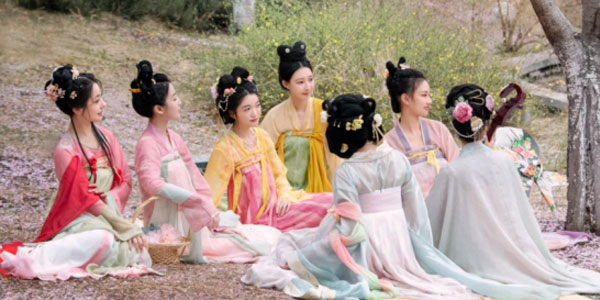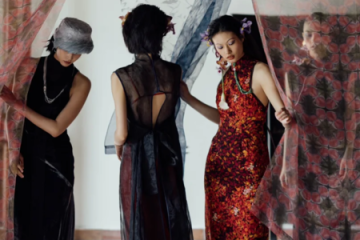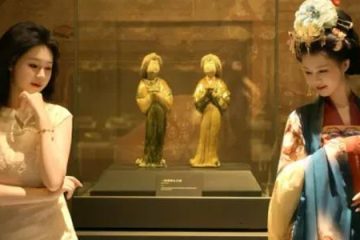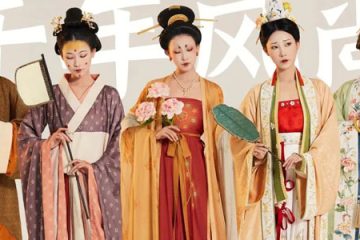Some “Insider Terms” in the Hanfu Community

Since hanfu originated in China, the Chinese hanfu community has been around longer and naturally developed its own set of insider terms or “slang.” Many Chinese outfits fans outside of China may not be very familiar with these. So in this post, we’ll look at some of the most commonly used terms on Chinese social media and explain what they mean.
Hanfu (汉服)
Let’s start with a question: what does hanfu actually refer to? You have two options:
A. The traditional clothing of the Han people (from the Yellow Emperor’s era up to the Ming Dynasty)
B. Clothing from the Han Dynasty only
If you chose option B, you can go ahead and click the little “X” in the corner to leave (just kidding!). 😏
On our site, besides hanfu from the Qin–Han period to the Ming dynasty, you’ll also find items like reconstructed or slightly modified Qing dynasty qizhuang (Manchu-style clothing) and even fairy-inspired “xianfu” outfits designed more for photoshoots than based on historical artifacts. If you’re curious about those styles, you can explore them on our website too.
Paozi (袍子)
In Chinese, pao means “long robe,” but within the hanfu community, paozi refers to hanfu enthusiasts. The term comes from the ancient poem Classic of Poetry · Qin Feng · Wu Yi which says:
“How can one say I have no clothes? I will share my robe with you.”
So if you meet fellow hanfu lovers in China, you can call each other páo zi.

Da Ming Youth (大明少年/少女)
This term describes young people who are especially fond of Ming-dynasty-style hanfu.
An Gang (暗杠)
This is a slang term for buying hanfu privately from shop owners instead of through public sales channels—kind of like a VIP-only transaction. (To be honest, it was the first time I heard this phrase myself)
Lailiao (来料)
Lailiao simply means Consumer-selected fabric. It’s basically the same idea as choosing your own fabric when getting a suit tailored—you pick both the material and the style.
Fangliang (放量)
Fangliang refers to adding a bit of extra room in the garment when tailoring hanfu, based on a person’s measurements. This ensures comfort while keeping the elegant look of hanfu.
For example, some hanfu styles have a lot of fangliang, which makes the wearer look more dignified and graceful—even ordinary people can appear striking in them. (By the way, this is especially common in Ming dynasty clothing, which is also very photogenic!)

On the other hand, sleeves that are cut too short can make the outfit look cramped and ruin the natural flow of the design. Historical hanfu artifacts actually show very generous sleeve fangliang: when you put your hands together, the edges of the sleeves would hang straight down, with both cuffs almost touching each other.

Fanche (翻车)
This means the actual product doesn’t match the promotional photos. Common issues include pleats on horse-face skirts that fall apart, crooked skirt panels, major color differences, wrong sizing, or embroidery patterns that don’t match what was advertised.
Cabbage Price (白菜价)
Cabbage originated in China and is cheap and abundant, so the phrase refers to hanfu that’s very affordable or considered a great bargain. But remember—low price doesn’t always mean good quality, so watch out for a “fanche!”
Fairy Fans
“xianfu” (Fairy-style, 仙服) refers to flowy, ethereal Chinese outfits with little concern for historical accuracy. People who love these—often inspired by Wei and Jin aesthetics or fantasy dramas—are sometimes called fairy-style fans (仙服党). Think of those all-white, gauzy outfits worn by immortals in TV shows: not historically correct, but perfect for dreamy photos.
Authenticity Fans
In contrast, form-focused fans (形制党/复原党) are the academic side of the hanfu community. They care deeply about historical accuracy, insisting that only garments backed by archaeological evidence or ancient paintings count as real hanfu.
They often recreate outfits down to the smallest detail, looking like they’ve stepped straight out of a historical scroll. (I really admire the way they recreate Chinese outfits looks)
Fairy Style vs. Authentic Style
“Fairy Style fans” and “Authenticity purists” sometimes clash online, each insisting the other doesn’t truly represent the hanfu community.
But at Silkdivas, we believe clothing is meant to serve people, not the other way around. If you love a certain style, go for it! Whether you lean toward dreamy, flowing outfits or strictly historical reconstructions, there’s room for everyone.
Instead of setting up rules or ranking systems—and tearing down those who don’t fit—why not show more tolerance and understanding toward different tastes? Constant infighting only makes the hanfu scene look unwelcoming to outsiders. It can even create the impression that hanfu enthusiasts are overly aggressive or hostile, which discourages newcomers from joining.

For Chinese outfits to truly grow, we need a community that’s open, inclusive, and encouraging. Let’s make space for beginners to experiment and express themselves, and work together to build a more harmonious hanfu culture.
Hanfu Revival
Let’s switch to something more uplifting—since the “Hanfu Revival Movement” began in 2003, hanfu has gone from a niche interest among dedicated fans to a mainstream cultural trend. The hanfu market has been growing by over 50% annually, and its beauty is now being appreciated by more and more people.
Hanfu Day / Shangsi Festival
Every year on the third day of the third lunar month, the Communist Youth League of China has designated Chinese National Costume Day, also known as Hanfu Day. This date coincides with the ancient Shangsi Festival (上巳节), a traditional Han holiday.
In the past, people would gather by rivers and streams to bathe, wash with orchid herbs, or sprinkle themselves with flower-infused water using willow branches—rituals meant to ward off misfortune and bring blessings.
Over time, activities like ancestral rituals, spring outings, banquets, and the famous “floating wine cups along winding streams” were added to the festival.
Today, hanfu celebrations have become popular across China. Well-known events include the Xitang (西塘) Hanfu Cultural Week, the China Silk Hanfu Month, and the Hanfu Huazhao (花朝) Festival. To be honest, I really want to go and see it too. 🤩



Summary
These days, people in China aren’t shy about wearing Chinese outfits in public anymore. Ever since the Dior “mamian skirt” controversy, many patriotic individuals have embraced hanfu to show that it has always been a uniquely Chinese tradition.
Did you enjoy this blog? Have you learned some new hanfu facts? Feel free to leave a comment or share it with others!



0 Comments